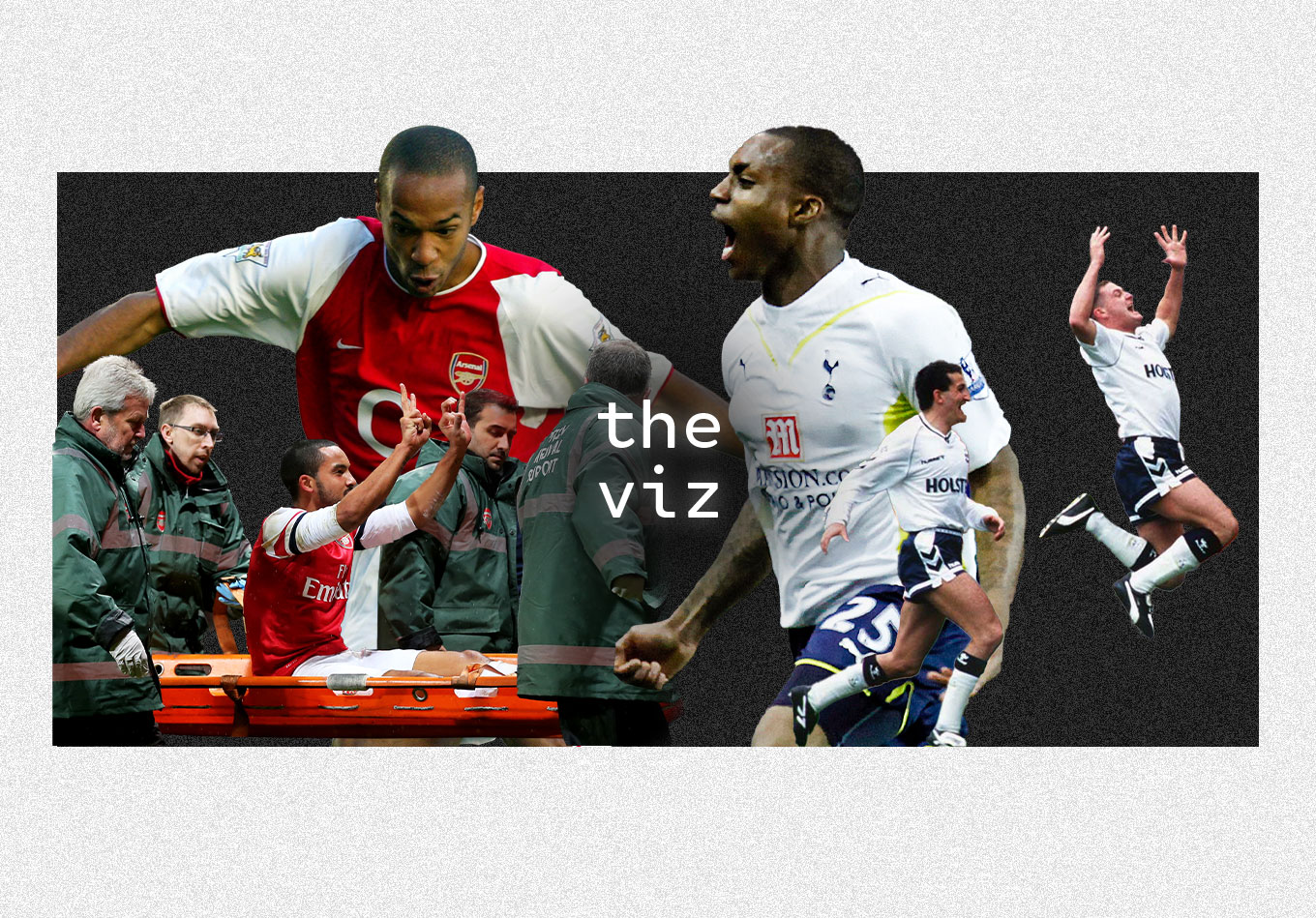Arsenal and Tottenham renew their rivalry this weekend, with Mikel Arteta’s side holding a five-point lead over Man City at the top of the Premier League table. One of the most famous fixtures in the English football league calendar, we’ve analysed how the north London derby has evolved over time with the help of a delightful array of data viz.
Sunday’s fixture will be the 172nd league meeting between Arsenal and Tottenham Hotspur, although only 163 of the previous English Football League matches between the pair have been considered a true derby.
Originally located south of the Thames in Plumstead, Arsenal eventually moved to north London in 1913. This move to Highbury incensed Tottenham, who believed this was their territory. Now true neighbours, the north London rivalry began.
The History
Arsenal lead the all-time Football League head-to-head record in this fixture, with 69 wins to Tottenham’s 55, though just five of those wins have come in the last 17 encounters (W5 D6 L6).
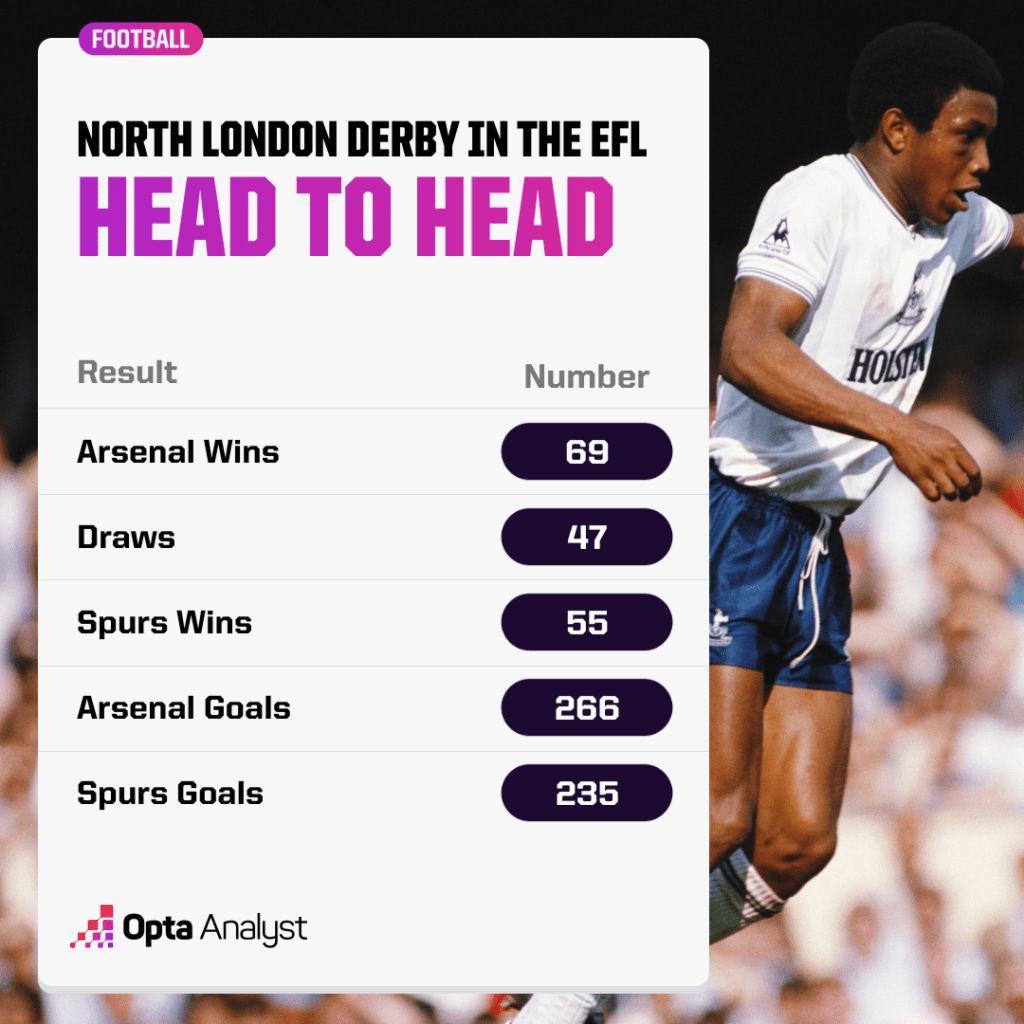
The Gunners enjoyed a dominant 3-1 victory over Spurs at the Emirates Stadium earlier this season, and as a result Arsenal are looking to complete their first league double over Tottenham since 2013-14, which was also their last league victory away against Spurs.
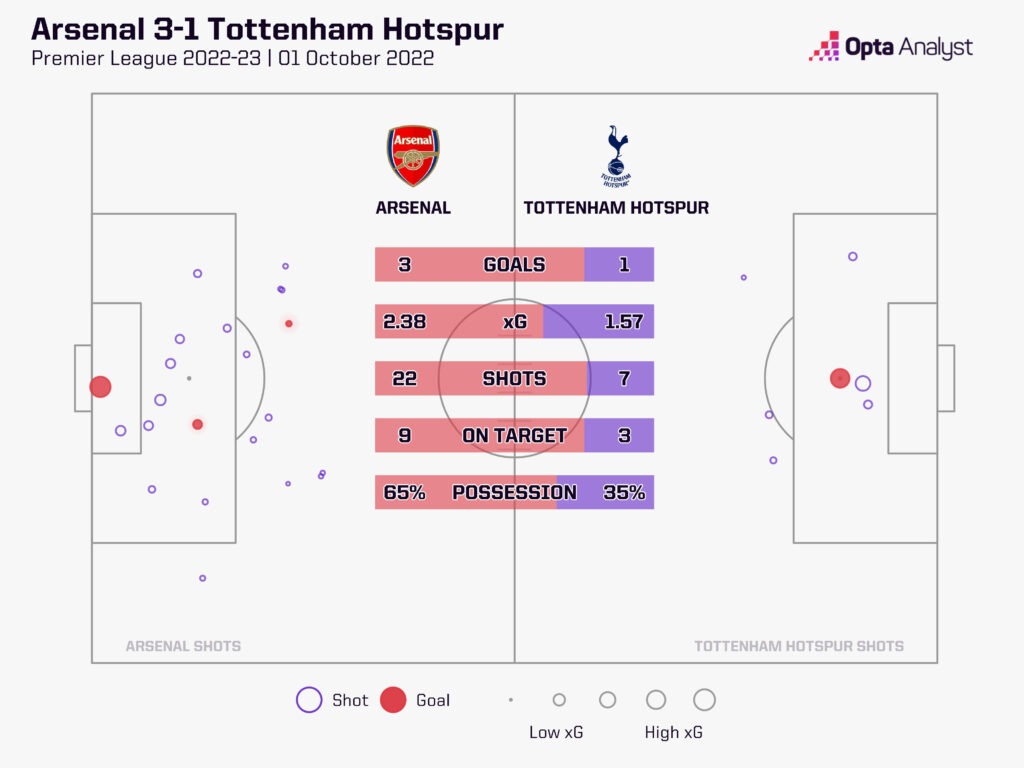
It won’t be an easy task, though, with Tottenham unbeaten in their last eight Premier League home games against Arsenal (W6 D2). They’ve won their last three at home against them but have never won four in a row in their league history.
This fixture pits two of the most successful clubs in English top-flight league history together, with only Manchester United (48.0%) and Liverpool (47.5%) boasting a higher win ratio in the top division in England than both the north London clubs.
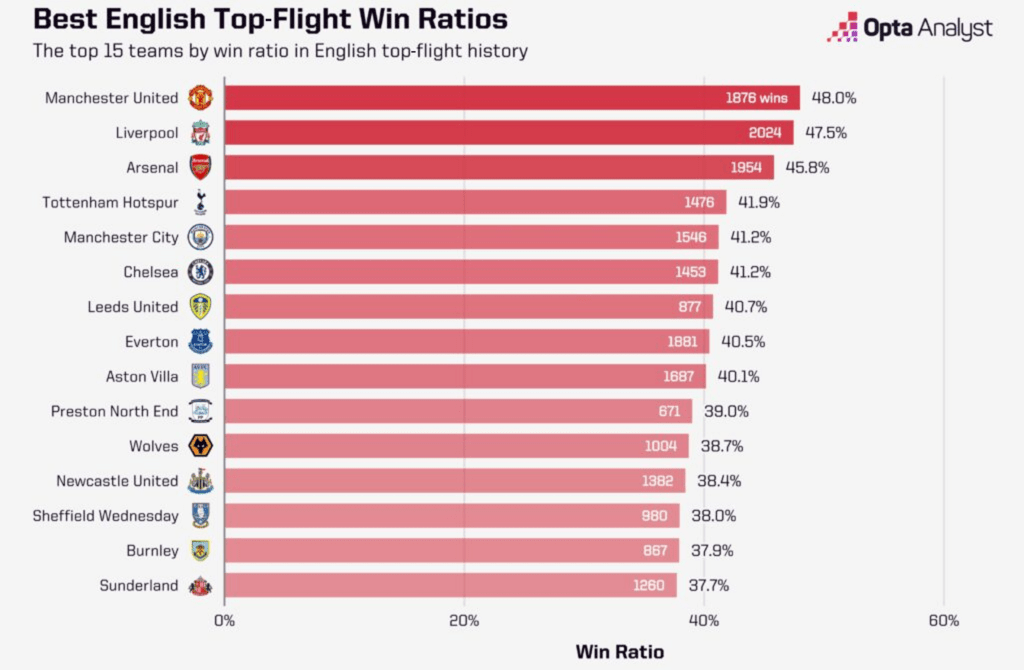
Arsenal have won 1,954 league matches in English top-flight history, second only to Liverpool’s 2,024, while their win ratio of 45.8% is the third best ahead of Spurs (41.9%) in fourth.
Tottenham are now just 24 wins away from becoming only the seventh team to tally 1,500 wins in top-flight league history in England, behind Liverpool, Arsenal, Everton, Manchester United, Aston Villa and Manchester City.
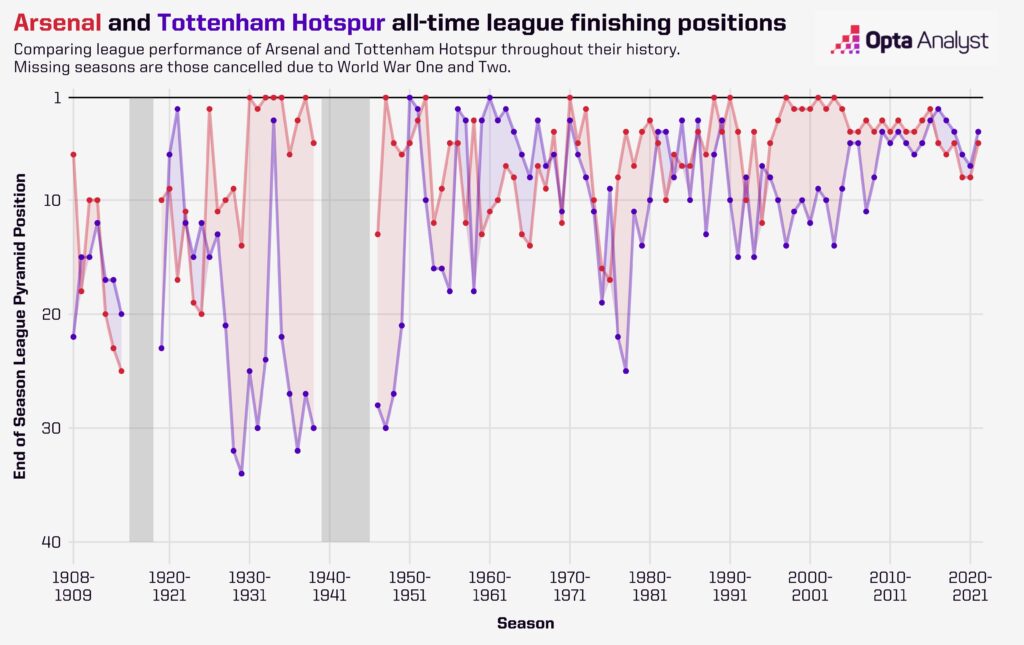
In terms of club success, Arsenal lead Spurs by quite a way for both league titles (13-2) and major trophies won overall (31-17). Just two of Spurs’ major honours have come in the last 31 years, with both of those coming in the League Cup (1998-99 and 2007-08). Arsenal have won four major titles since Spurs’ last trophy, all of them FA Cups, a competition that they have won more often than any other team (14).
Arsenal have finished above Spurs in the league pyramid in 67 different seasons since their first campaign together in the EFL (1908-09). Twenty-one of those came consecutively between 1995-96 and 2015-16, which is the longest run of supremacy (either way) between these clubs in league history.
But Arsenal’s dominance in the Premier League era hasn’t lasted…
The Premier League
The phrase ‘mind the gap’ became synonymous with Arsenal’s league dominance over Spurs across that 21-season period, but the tide has turned since. As it stands, Spurs are on a six-season run of finishing above their rivals in the Premier League, but with Arsenal currently 11 points clear of Spurs in the Premier League standings – and having played a game fewer – it looks like 2022-23 will put an end to that streak.
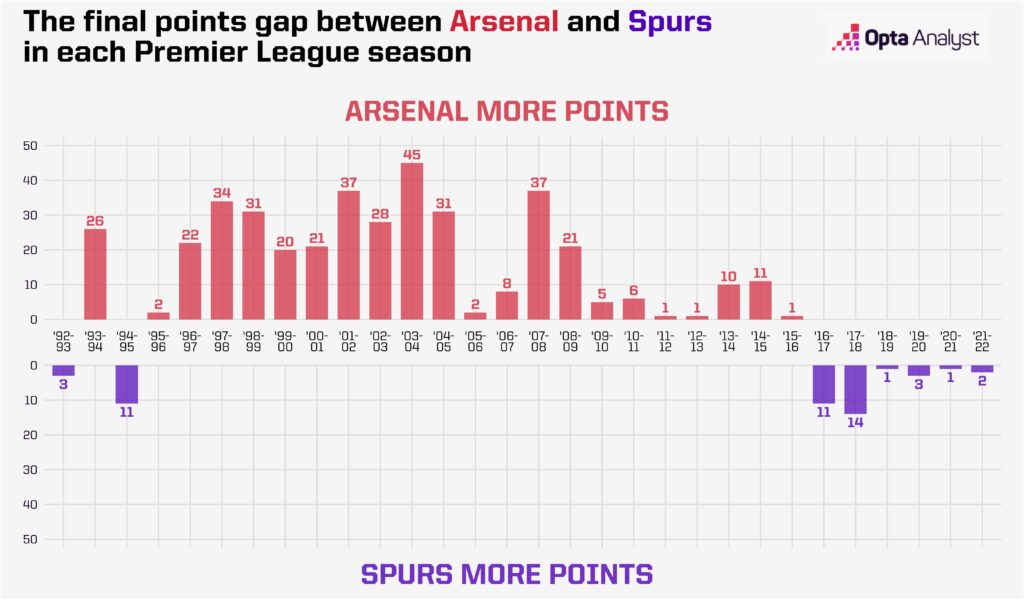
Arsène Wenger had never finished below Spurs in the Premier League as Arsenal manager until his final two seasons at the club, including finishing 14 points behind Spurs in his final season in charge. Spurs’ current run of six successive seasons above Arsenal in the English league system is their longest run since the late 1960s, when they finished nine successive First Division campaigns ahead of their rivals between 1959-60 and 1967-68.
Between 2002-03 and 2003-04, Arsenal were the dominant force in north London. They enjoyed as much as a 1.32 points-per-game average higher than Spurs over a 38-game period in April 2004. Over time, Tottenham have caught up with Arsenal, and led the Gunners for the majority of time between April 2016 and September 2021.
Since the end of last season, the two sides are the closest they’ve ever been in the Premier League era. On 16 October, they even had the exact same PPG average across their previous 38 matches (2.08).
Since then, Spurs have hit poor form while Arsenal’s unbeaten run keeps on going. Coming into this match, Arsenal’s 38-game PPG average is 2.21, well ahead of Spurs’ 1.87.
The 2022-23 Title Race
Arsenal last won the Premier League 19 years ago, when the 2003-04 season saw them top the table by 11 points under the management of Wenger. The 17 seasons between then and now have been a progressive struggle, with Arsenal eventually failing to qualify for any European competition for the first time since 1995-96 after an eighth-place finish in the Premier League in 2020-21. Last season was better, in comparison, with their fifth-position finish enough to get back in the UEFA Europa League.
While many Arsenal fans saw signs of promise under Arteta, few would have expected them to crystallise so soon. 2022-23 has been a dream for the Gunners so far.
Based on three points for a win, this is Arsenal’s best-ever start to a league season (44 points). It took them until their 24th match of 2021-22 to reach this tally, seven games more than they’ve currently played.
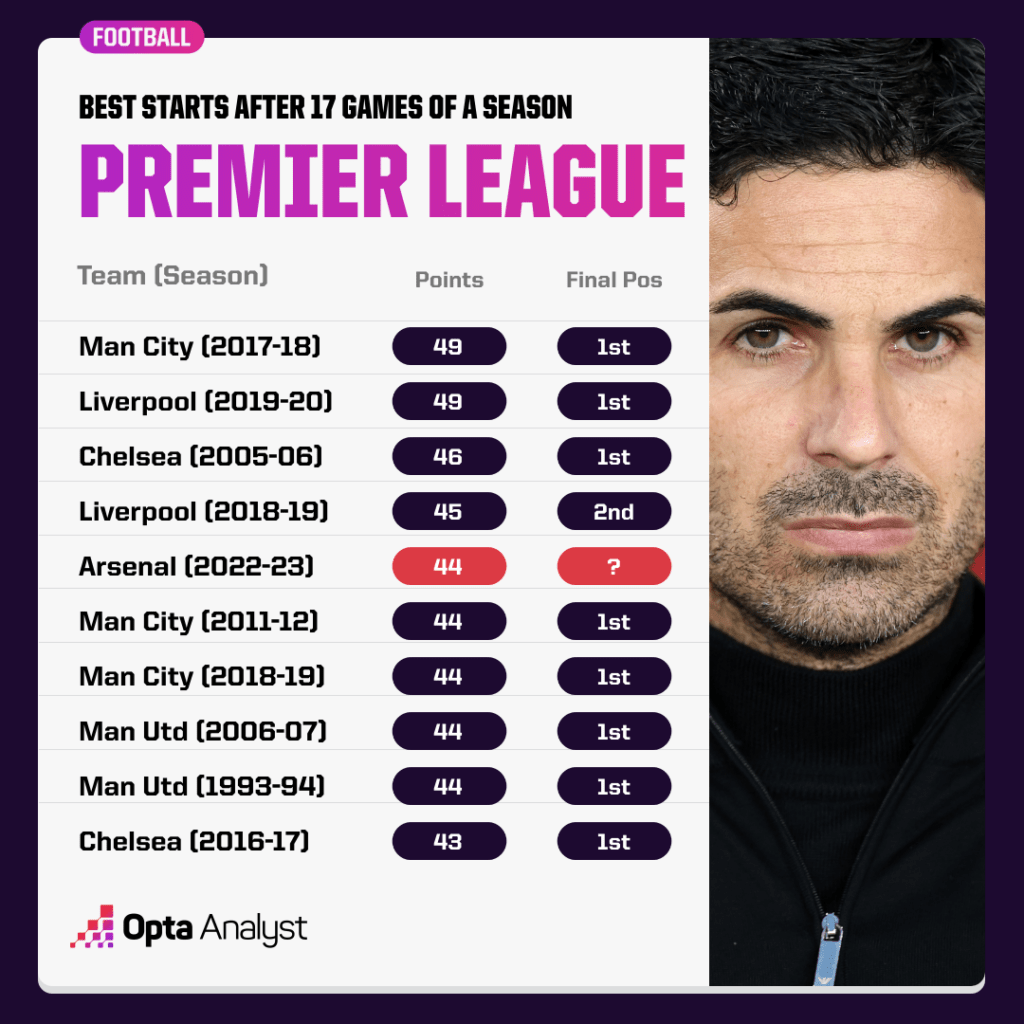
Across Premier League history, only four teams have won more points at this stage of a Premier League season, while nine of the 10 teams to win at least 43 points after 17 games have won the title. The only exception to that rule is Liverpool in 2018-19, who finished second behind an exceptional Manchester City team that went on to secure 98 points, one more than the Reds (97).
The Styles
After Manchester City’s 3-2 defeat to Tottenham in February, Pep Guardiola said that Spurs were “deep and compact” and “created a lot of space to run on the counter-attack”. Antonio Conte was almost offended by that suggestion, posting on Instagram to bite back.
But Conte was surely posting in jest. There’s no shame in being a counter-attacking team, and Spurs have been one of the best at doing it since the Italian arrived at the club in November 2021.
So far in 2022-23, Spurs have maintained a much deeper shape than the other clubs in the ‘big six’, averaging much less of the ball in the final third than those teams.
Just 22% of Spurs’ successful passes have ended in the final third in the Premier League this season – that’s only higher than Leicester City (20%) across the whole division.
Compare that to Arsenal (30%), Chelsea (25%), Man Utd (27%), Man City (27%) and Liverpool (24%) and Tottenham are the lowest of the ‘big six’ sides in 2022-23 so far.
In fact, Arsenal’s average is the second highest in the league behind Newcastle (31%), which is impressive considering only Chelsea, Liverpool and Man City have averaged more successful passes per game than Mikel Arteta’s side (440.4) in 2022-23.
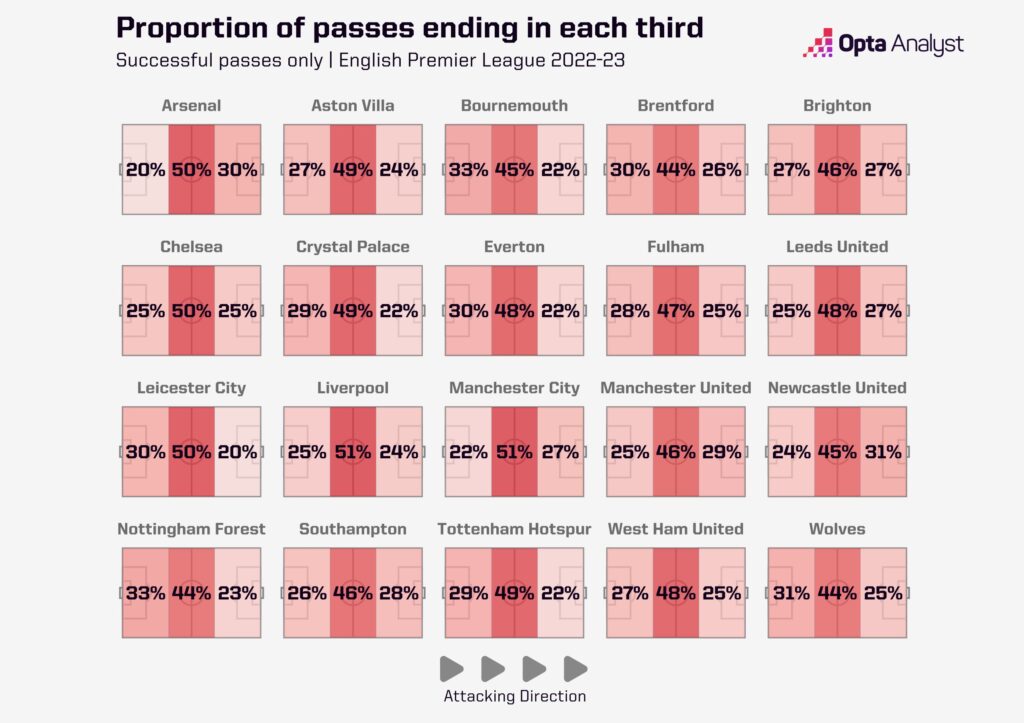
Field tilt is a metric to show the territorial dominance between teams. It measures the share of possession a team has in a game, considering only touches or passes in the attacking third. It can be useful when trying to understand which team is more dominant in games. Rather than looking at overall possession, field tilt shows us whether teams are able to get the ball into the areas that matter.
When we look at the field tilt numbers in the Premier League this season, the stark difference between Spurs and Arsenal’s willingness to hold possession in attacking areas becomes even more evident.
Only Manchester City (75.9%) have a higher field tilt than Arsenal (65.1%) in the Premier League this season, while Spurs’ average (45.5%) is the 13th highest – lower than the two bottom teams in the league table Southampton (46.9%) and Wolves (47.9%).
In Arsenal’s 3-1 win over Spurs back in October, the Gunners’ field tilt was 81.0% – one of only 27 occasions this season that a team has been this high – although this is partly explained by Emerson Royal’s 62nd-minute red card for Tottenham.
Direct Attacks: The number of open-play sequences that start just inside the team’s own half and have at least 50% of movement towards the opposition’s goal and end in a shot or a touch in the opposition box.
Direct Speed: How quickly teams progress up the pitch in open-play sequences, measured in metres per second.
Because Spurs set their stall out deeper than many other teams, this also makes them harder to counter against. Only Manchester City (1.15 m/s) have seen opponents attack them with a lower direct speed than Conte’s team in 2022-23 (1.17 m/s).
In comparison, opponents have attacked Arsenal with a direct speed of 1.51 m/s this season in the Premier League – the fourth fastest in the division.
Sitting deeper makes Spurs much more compact in shape, which in turn makes it much harder for opponents to generate clear shooting opportunities. It also means that carelessness in deeper positions – which has often been the case – can lead to opponents turning the ball over high up the pitch. No team have allowed opponents more high turnovers in the Premier League this season than Spurs (104), with 20 of these ending in shots (fifth most).
The average xG for non-penalty shots faced by Spurs this season is just 0.077 – essentially meaning that the average expected shot conversion rate of these shots is 7.7%. That’s a league low value, ahead of Newcastle United’s 0.079 (7.9%).
Arsenal, in comparison, give their opponents an average non-penalty xG per shot of 0.094 (9.4%), while Liverpool are the league’s worst in this metric at 0.131 (13.1%).
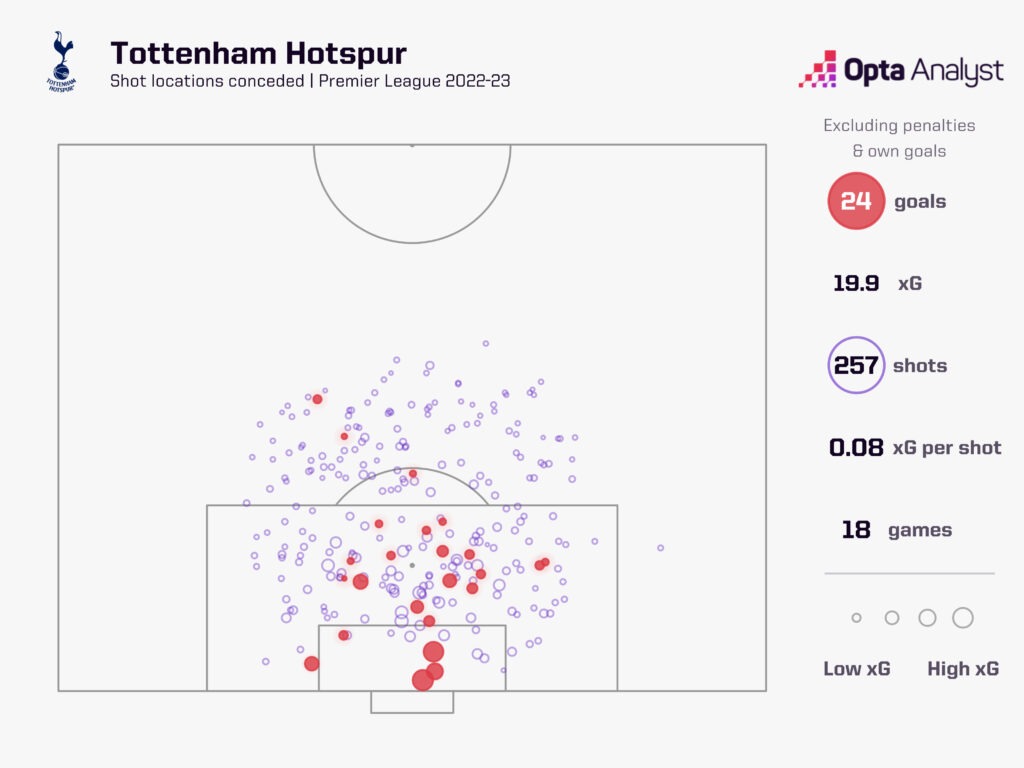
Arsenal do concede a lower non-penalty xG figure per game on average (0.76) than Spurs do (1.10), but sometimes it’s a case of what you prefer. Is it better to give away higher-quality shots on a less frequent basis over the average 90 minutes (Arsenal) or allow opponents to accumulate more shots but at a lower quality on average (Tottenham)?
The Comebacks
This fixture has been one of the most entertaining since the inaugural Premier League season in 1992-93.
The north London derby is the joint-second highest scoring fixture in Premier League history (175), behind only Arsenal-Liverpool (180), and level with Liverpool-Spurs (175). Twenty-two of those goals have come from the penalty spot, which is a record tally for a single fixture in the competition.
Ten Premier League north London derbies have seen the team that scored the first goal go on to lose the match, including two of the last six league meetings. Only Spurs-Southampton (13) and Chelsea-Sunderland (11) have seen a side win the fixture after conceding the opening goal more often.
Spurs have thrown away leads in 19 of their previous 61 Premier League meetings with Arsenal, with 11 of these coming away at the Gunners.
Overall, they’ve dropped 45 points from leading positions against Arsenal in Premier League history, which is more than any other club against a single opponent.
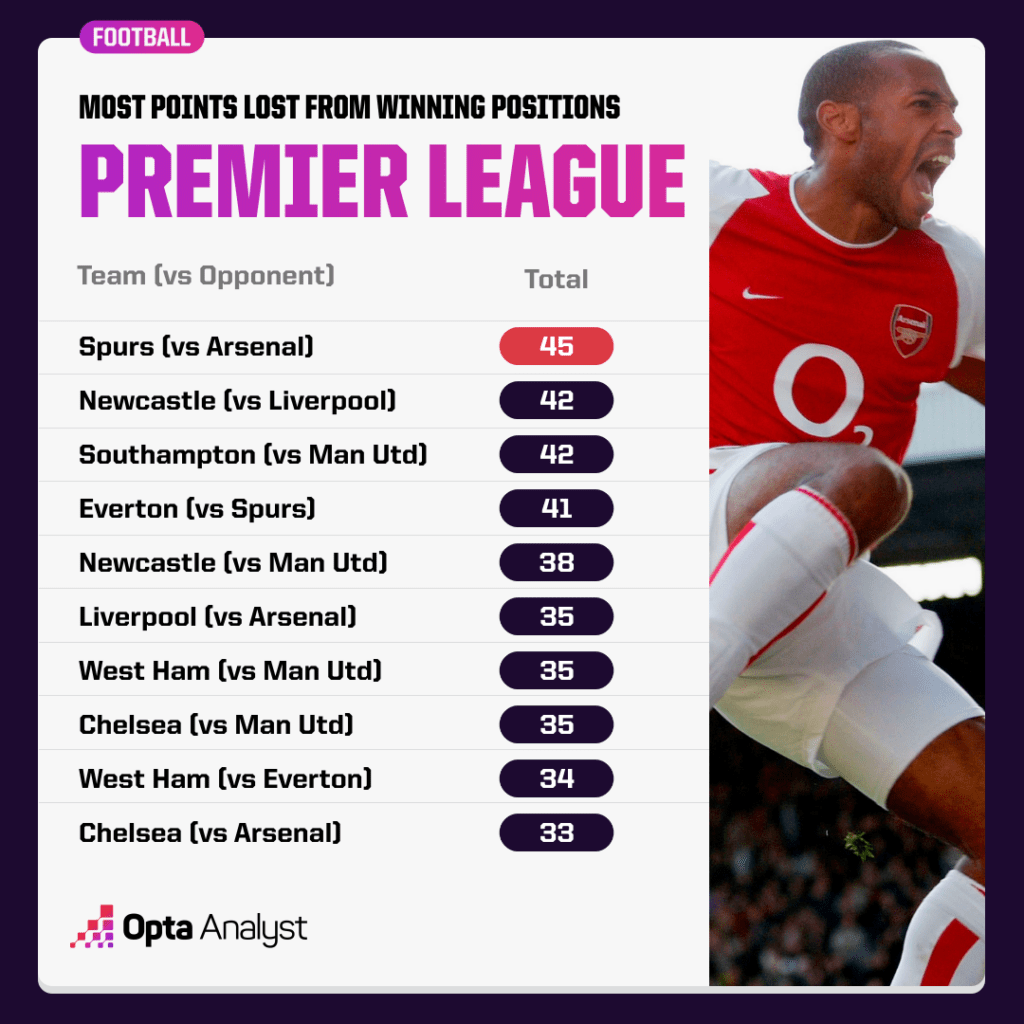
There have been six goals scored in the 90th minute (or later) in Premier League history in matches between Arsenal and Spurs. All four of Spurs’ have been equalisers, the last of which was arguably the most dramatic of all. Aaron Lennon’s goal in the fourth minute of stoppage time in October 2008 at the Emirates rescued a point despite Spurs being his side being 4-2 down in the 89th minute.
Weirdly, there’s never been a winning goal scored in the 90th minute or later in a Premier League north London derby. In comparison, the Merseyside derby between Liverpool and Everton has seen a league-high five.
That comes as more of a surprise when you realise Spurs have suffered more 90th-minute defeats than any other team in Premier League history (24), while only Liverpool (54) have seen more Premier League games decided by a 90th-minute winner than Tottenham (53).
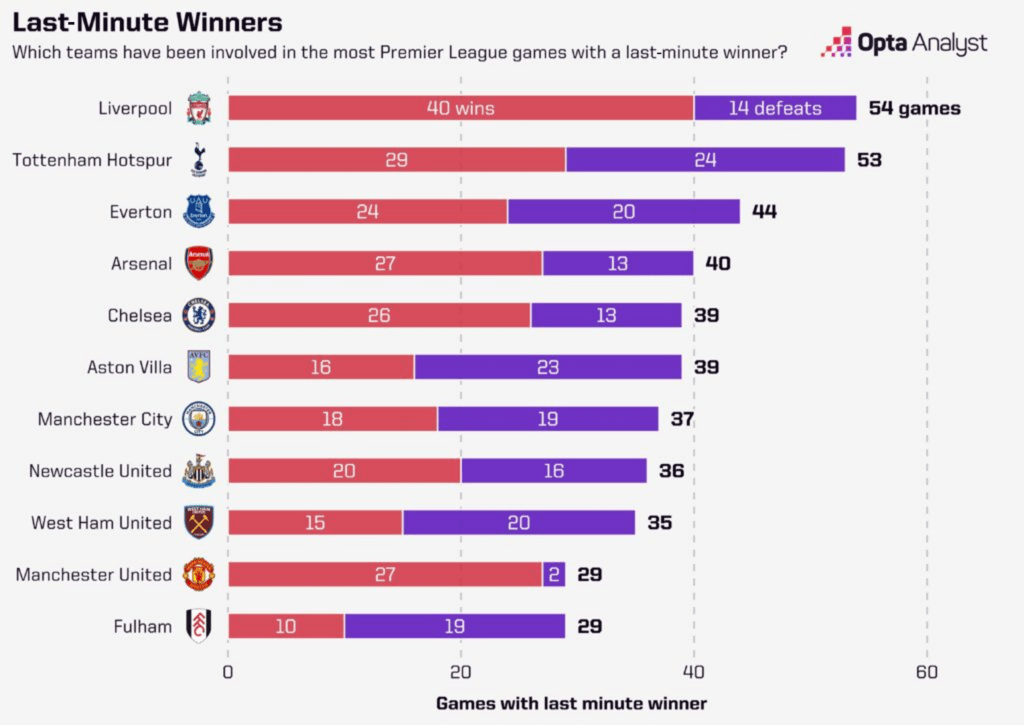
The Experience
So far in 2022-23, Arsenal have the youngest average starting lineup in the Premier League (24 years, 232 days old), yet they still top the league table. Having a young, fresh side is an Arteta trademark.
The average age of Arsenal’s starting XI last season was 24 years and 308 days old – the sixth-youngest ever and the youngest across a full Premier League campaign since 2014-15 – which happened to be Mauricio Pochettino’s Spurs’ side (24y 282d).
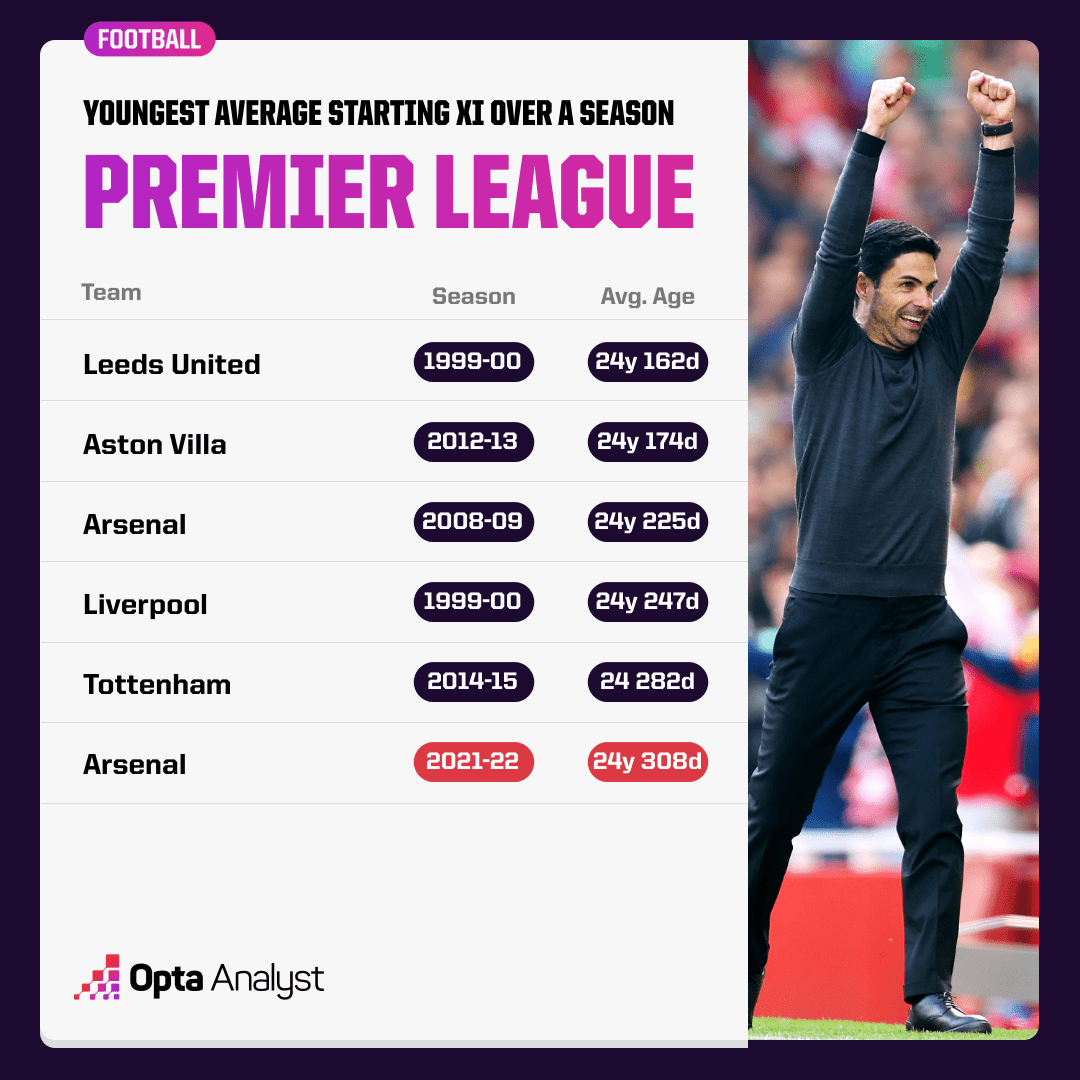
With youth comes relative inexperience, and that was ultimately telling when Arsenal and Spurs last met in the league at the Tottenham Hotspur Stadium in May 2022. The hosts ran out 3-0 winners, with Arsenal not helped by an early red card. Tottenham’s starting XI (26y 341d) was almost two years older than Arsenal’s (25y, 54d), while their starters had played a combined 800 more Premier League games than the Gunners’ (1,731 vs 931).
Another area where experience proved crucial last season was in the two managers. Though a graduate and disciple of Pep Guardiola, this is still Arteta’s first job in management, while Conte is (rightly) a highly revered top-flight coach. At club level alone, the Italian has managed well over 400 more games than Arteta, with five top-flight titles to his name to boot.
The Record Goalscorer
Harry Kane loves playing against Arsenal.
The Spurs and England captain has scored 14 times against Arsenal overall, with all of those goals coming in the Premier League. He’s the highest-scoring player in north London derby history, ahead of Bobby Smith and Emmanuel Adebayor (10). Adebayor, incidentally, is the only player in Premier League history to score for both clubs in this fixture, with Jimmy Robertson the only other player to do it in all-time history.
Kane has also scored more Premier League goals against Arsenal (14) than against other other side. That’s helped by the fact he’s both taken and scored more penalties against the Gunners than any other player in the history of the competition (seven).
The striker has scored against four different Arsenal goalkeepers – David Ospina (three), Petr Cech (four), Bernd Leno (four) and Aaron Ramsdale (three) – and nine of these have come in home games.
Just six players have scored more goals against a single opponent in Premier League history, with Kane’s 18 goals against Leicester just behind the competition record held by Alan Shearer against Leeds United (20).
Kane has scored with 19.7% of his shots in the Premier League against Arsenal – that’s higher than his Premier League average conversion rate against every other club combined (17.6%).
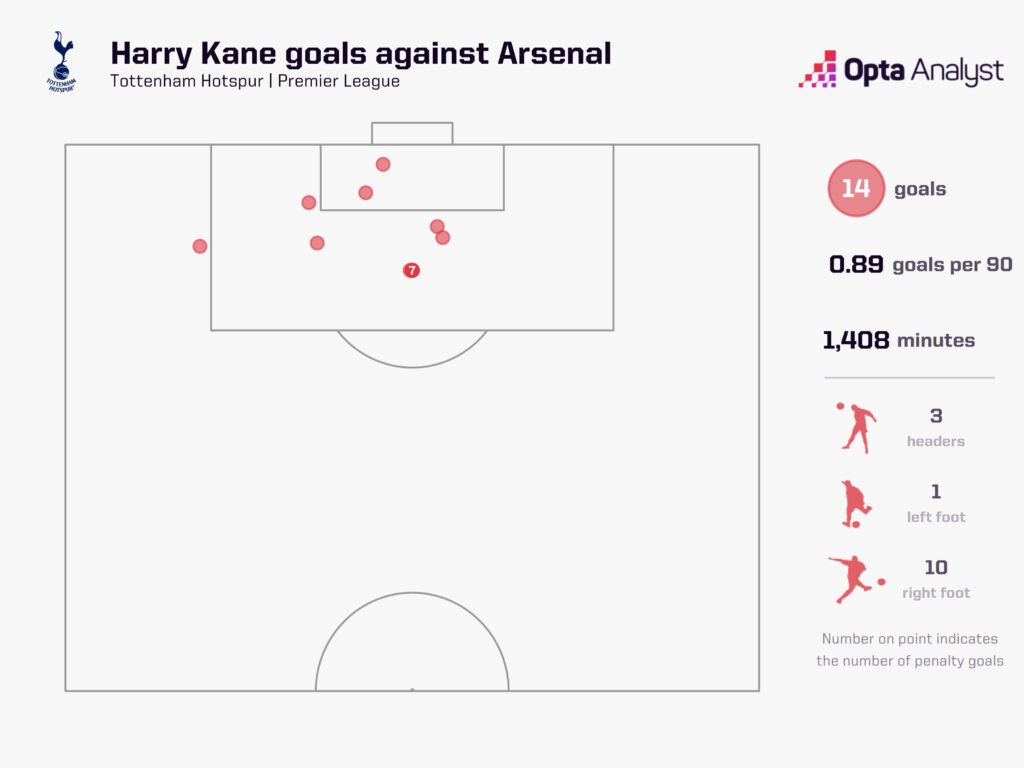
Kane is now two goals away from becoming just the 28th man to score 200 English top-flight league goals in the history of the EFL. His 198 goals have come in exactly 300 top-flight appearances, giving him an exceptional ratio of 0.66 goals per game.
As it stands, that rate of 0.66 goals a game in top-flight league football is an average bettered by just eight of the 27 players to have scored 200-plus goals in English top-flight history, and stronger than post-war greats like Shearer (0.51), Denis Law (0.53), Steve Bloomer (0.59) and Ian Rush (0.45).
When Kane does hit this landmark, he’ll become the first player to reach 200 top-flight league goals for an English club since Ian Rush did so for Liverpool in August 1993 – just shy of three decades ago. Before Rush, it was the late, great Jimmy Greaves who did this for Spurs in the late 1960s (220 goals in Division One).
Just three of the 27 players on the chart below have surpassed 300 goals: Greaves (357), Steve Bloomer (314) and Dixie Dean (310).
Kane will have sights on reaching that landmark too, should age and injuries stay on his side.
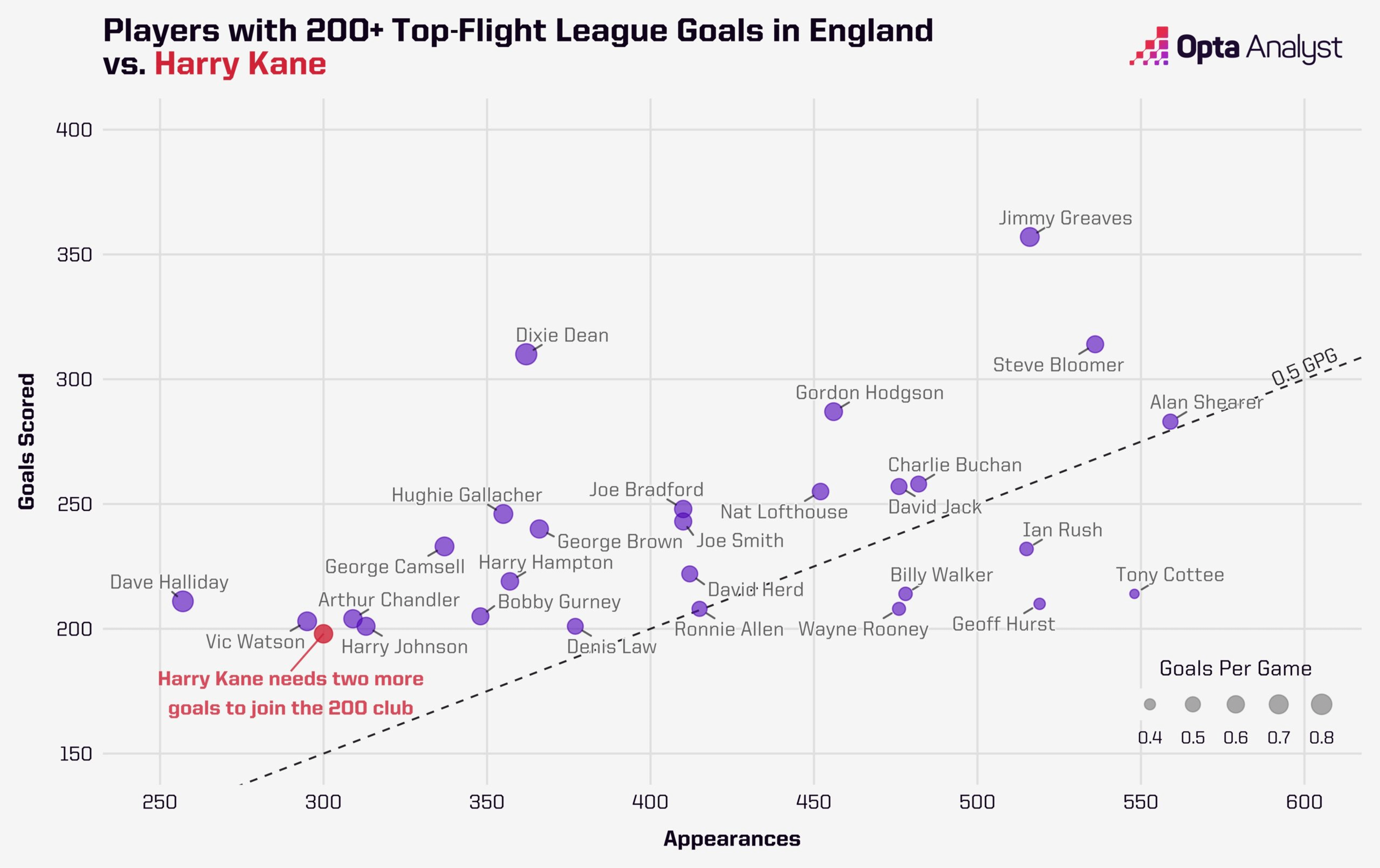
Enjoy this? Subscribe to our newsletter to receive five stories each Friday.
